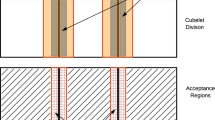Abstract
The two-step, False Discovery Rate-based thresholding procedures presented by Clements and Sarkar in this volume offer a computationally efficient means by which to detect faint sources lurking in collections of megapixel and gigapixel images. We compare Clements and Sarkar’s Procedure 35.1 with the False Cluster Proportion-based algorithm of Friedenberg and Genovese (arXiv:0910.5449, 2009). The former employs pixel-wise error control, while the latter employs cluster-wise error control. We find the two techniques yield source lists of similar efficiency (finding ≈ 50% of the sources detected by a more computationally intensive procedure) and purity ( ≈ 100%), if one eliminates single-pixel detections made by the Clements and Sarkar procedure. We propose that the Clements and Sarkar procedure be refined such that only statistically significant clusters are retained in the final source list, mitigating the issue of single-pixel detections and potentially improving the procedure’s efficiency.
Access this chapter
Tax calculation will be finalised at checkout
Purchases are for personal use only
Similar content being viewed by others
Notes
- 1.
- 2.
We note that, depending on the algorithm, a putative source may be rejected before being listed: for instance, in WAVDETECT, putative sources are rejected if they are detected only when the image-smoothing wavelet scale is smaller than that of the telescope’s point-spread function (PSF).
- 3.
F&G run their algorithm assuming a false cluster proportion of 0.1.
References
Bertin, E. and S. Arnouts (1996, June). SExtractor: Software for source extraction. Astronomy and Astrophysics Supplement Series 117, 393–404.
Ebeling, H. and G. Wiedenmann (1993, January). Detecting structure in two dimensions combining Voronoi tessellation and percolation. Physical Review E 47, 704–710.
Freeman, P. E., V. Kashyap, R. Rosner, and D. Q. Lamb (2002, January). A Wavelet-Based Algorithm for the Spatial Analysis of Poisson Data. The Astrophysical Journal Supplement Series 138, 185–218.
Friedenberg, D. A. and C. R. Genovese (2009, October). Straight to the Source: Detecting Aggregate Objects in Astronomical Images with Proper Error Control. arXiv:0910.5449.
Giacconi, R., A. Zirm, J. Wang, P. Rosati, M. Nonino, P. Tozzi, R. Gilli, V. Mainieri, G. Hasinger, L. Kewley, J. Bergeron, S. Borgani, R. Gilmozzi, N. Grogin, A. Koekemoer, E. Schreier, W. Zheng, and C. Norman (2002, April). Chandra Deep Field South: The 1 Ms Catalog. The Astrophysical Journal Supplement Series 139, 369–410.
Perone Pacifico, M., C. Genovese, I. Verdinelli, and L. Wasserman (2004). False discovery control for random fields. Journal of the American Statistical Association 99(468), 1002–1014.
Author information
Authors and Affiliations
Corresponding author
Editor information
Editors and Affiliations
Rights and permissions
Copyright information
© 2012 Springer Science+Business Media New York
About this paper
Cite this paper
Freeman, P.E. (2012). Commentary: Astronomical Transient Detection Controlling the False Discovery Rate. In: Feigelson, E., Babu, G. (eds) Statistical Challenges in Modern Astronomy V. Lecture Notes in Statistics(), vol 902. Springer, New York, NY. https://doi.org/10.1007/978-1-4614-3520-4_37
Download citation
DOI: https://doi.org/10.1007/978-1-4614-3520-4_37
Published:
Publisher Name: Springer, New York, NY
Print ISBN: 978-1-4614-3519-8
Online ISBN: 978-1-4614-3520-4
eBook Packages: Mathematics and StatisticsMathematics and Statistics (R0)




